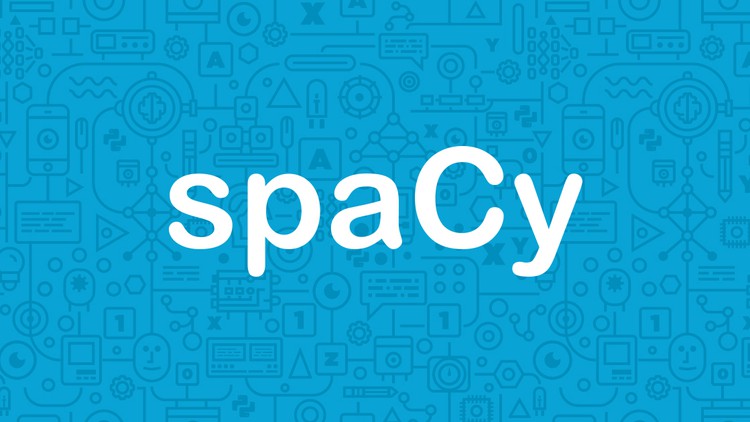Introduction to Spacy for Natural Language Processing
- Description
- Curriculum
- FAQ
- Reviews
Welcome to “Introduction to Spacy for Natural Language Processing”! In this course, you will learn how to use the powerful Spacy library to perform various natural language processing tasks such as tokenization, tagging, parsing, and named entity recognition.
You will start by learning the basics of Spacy and how to install and use it in your Python projects. From there, you will dive into more advanced topics such as using Spacy’s pre-trained models, creating custom pipeline components, and working with large datasets.
Throughout the course, you will work on real-world examples and hands-on exercises to solidify your understanding of the concepts. By the end of the course, you will have the skills and knowledge needed to confidently use Spacy in your own NLP projects.
This course is suitable for beginners to NLP and Spacy, as well as experienced developers looking to expand their skills. Sign up now and start your journey to mastering Spacy and NLP!
Spacy is a popular natural language processing library for Python that provides a wide range of features for working with text data. Some of the key features of Spacy include:
- Tokenization: Spacy can quickly and accurately tokenize text into words and punctuation, making it easy to work with individual words and phrases.
- Part-of-speech tagging: Spacy can identify and label the part-of-speech of each token in a sentence, such as nouns, verbs, adjectives, and more.
- Named entity recognition: Spacy can identify and label specific entities in a text, such as people, organizations, and locations.
- Dependency parsing: Spacy can analyze the grammatical structure of a sentence and identify the relationships between words, such as subject-verb-object.
- Sentence detection: Spacy can detect and segment text into individual sentences, making it easy to work with multiple sentences at once.
- Pre-trained models: Spacy includes pre-trained models for various languages, which can be easily loaded and used for tasks such as part-of-speech tagging and named entity recognition.
- Custom pipeline components: Spacy allows developers to create custom pipeline components, which can be added to the existing pipeline to perform specific tasks.
- Speed and efficiency: Spacy is designed to be fast and efficient, making it a good choice for working with large datasets.
- Integration with other libraries: Spacy can be easily integrated with other popular Python libraries such as pandas, numpy, and scikit-learn for data analysis and machine learning tasks.
Spacy can be used in machine learning and deep learning in a number of ways. Some common use cases include:
- Text classification: Spacy’s pre-trained models and custom pipeline components can be used to extract features from text data, which can then be used as input to a machine learning model for text classification tasks such as sentiment analysis or topic classification.
- Named entity recognition: Spacy’s pre-trained models for named entity recognition can be used to extract named entities from text data, which can be used as input to a machine learning model for tasks such as entity linking or knowledge graph construction.
- Text generation: Spacy can be used to preprocess text data and tokenize it into a format that can be used as input to a deep learning model for text generation tasks such as language translation or text summarization.
- Text summarization: Spacy can be used to extract key phrases and entities from a text and use it as input to a deep learning model for text summarization tasks.
- Text similarity: Spacy can be used to tokenize and vectorize text, which can then be used as input to machine learning models that calculate text similarity or perform tasks such as document clustering.
- Text-to-Speech and Speech-to-Text: Spacy can be used to pre-process text data, tokenize and extract key phrases and entities, which can be used in TTS and STT models.
Overall, Spacy can provide a powerful set of features for natural language processing that can be easily integrated with machine learning and deep learning models to improve the performance of a wide range of NLP tasks.
-
2Code FilesText lesson
-
3Spacy 3 IntroductionVideo lesson
-
4TokenizationVideo lesson
-
5Part of Speech (PoS) TaggingVideo lesson
-
6Visualizing Dependency Parsing with DisplacyVideo lesson
-
7Sentence Boundary DetectionVideo lesson
-
8Stop WordsVideo lesson
-
9LemmatizationVideo lesson
-
10Stemming in NLTK - Lemmatization vs Stemming in NLPVideo lesson
-
11Word Frequency CounterVideo lesson
-
12Rule Based Matching in Spacy Part 1Video lesson
-
13Rule Based Token Matching Examples Part 2Video lesson
-
14Rule Based Phrase Matching in SpacyVideo lesson
-
15Rule Based Entity Matching in SpacyVideo lesson
-
16NER (Named Entity Recognition) in Spacy 3 Part 1Video lesson
-
17NER (Named Entity Recognition) in Spacy 3 Part 2Video lesson
-
18Word to Vector (word2vec) and Sentence Similarity in SpacyVideo lesson

External Links May Contain Affiliate Links read more





